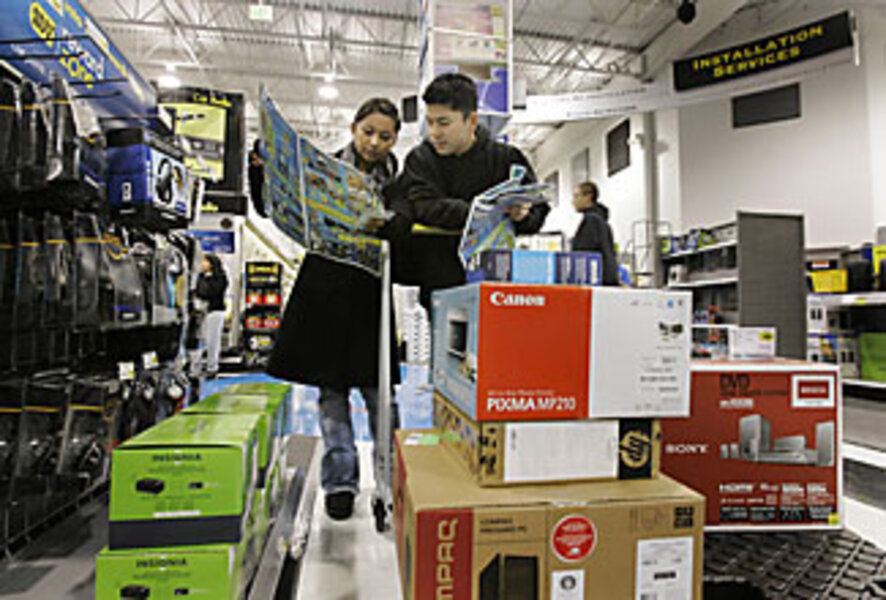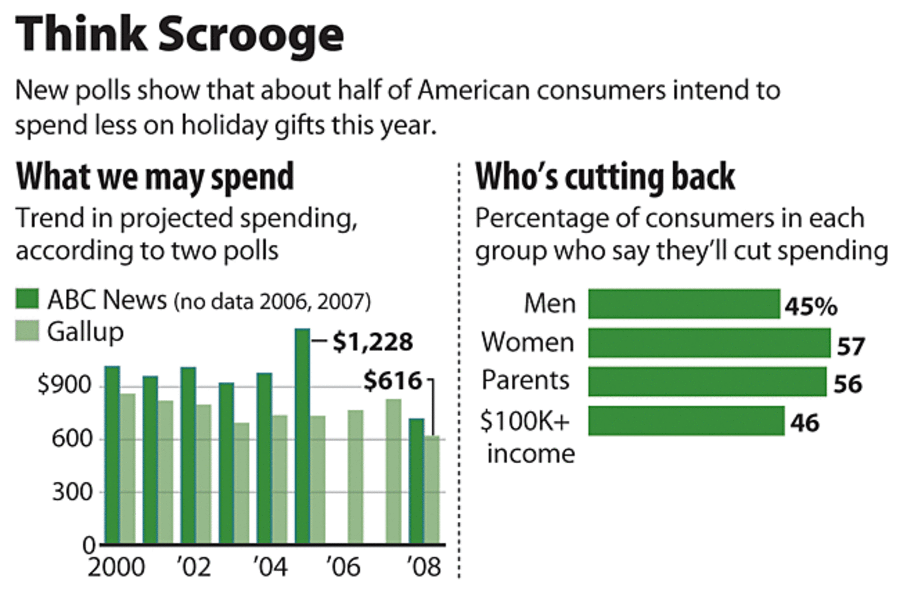The year of holiday thrift
Loading...
| New York
The United States is becoming a nation of frugal bargain hunters.
This holiday period, Americans of all backgrounds are discovering what it takes to become a professional penny pincher and what makes a dollar stretch.
Some are forgoing the department store for Wal-Mart or Target. Gift givers are crowding into Goodwill or the local thrift store. Coupon clipping has practically become a new religion. And the latest stories to tell at parties start with: "Want to hear how I haggled with the merchant?"
Evidence of this declining interest in shopping came Wednesday, when the US Commerce Department reported that personal spending in October fell by 0.5 percent after falling 3.7 percent in the third quarter.
The deal hunters are expected to be out even more the day after Thanksgiving, when retailers traditionally use promotions and sales to entice Americans to shop. One early survey shows that 45 percent of Americans, up nine percentage points from last year, plan to look for high-definition television sets at reduced rates or anything else that discounters plan to offer at a low, low price.
"Almost half the people polled are looking to save money," says Erin Hershkowitz, a spokeswoman for the International Council of Shopping Centers, which did the early survey of shoppers. "The one retail sector still showing positive results is the discounters."
It's no surprise that the main catalyst for the transformation is the economy. The decline in US housing prices, for example, is making it increasingly difficult to use the house as a piggy bank. This lesson hit hard for Leah Ingram of New Hope, Pa.
In the good old days – only a few years ago – Ms. Ingram and her husband took advantage of the rising price of their house by refinancing and pulling out their equity in cash.
"We took out a bona fide home-equity line, too, and put a front porch on the old house," Ingram recalls. "We took a cruise and six months later did it again."
That was then. When they sold their old house, they got less than anticipated. When they bought a new house, their payments were higher – while they have the same income. Now, she scans the circulars for coupons every week, and she visits thrift shops for her clothes.
"We went from living $500 a month in the red to $800 in the black," says the freelance writer.
Her daughters have also embraced the concept, shopping at Plato's Closet, which sells designer-name children's clothes at a discount. "My 11-year-old loves Abercrombie clothes and saw a T-shirt for $50," Ingram recounts. "She said, 'Who can spend that kind of money? I can go to Plato's and get one for $15.' "
Ingram's spending regimen extends to the holidays. She will make her own holiday decorations. "Two years ago, I would have gone to the gardening center and bought pine boughs," she says. "Now, I can't do that anymore."
She isn't the only one economizing. Businesses that help people save report that business is booming. At Coupons.com, business is up 50 percent in the past three months. Consumer savings using Coupons.com have soared from $26 million in August to $40 million in October.
"We've never seen the rate of use this high at this time of year," says Steven Boal, CEO of the company, which is based in Mountain View, Calif. "People are branching out into lots of different categories and searching the site more frequently."
Thrift and resale stores also are expecting a merry holiday season, a continuation of a strong year. In a recent survey of its members, the National Association of Resale & Thrift Shops (NARTS) found that September and October sales increased an average of 35 percent over last year for 74 percent of those surveyed.
One shopper at Goodwill in New London, Conn., is Julie Wernau, who purchased a Roomba vacuum cleaner for $15. "My husband needs to do some repairs on it," she says. "You can find good bargains at Goodwill, but you have to go often or someone else will snatch it up," advises the Quaker Hill, Conn., resident.
When they can, people are opting for something that's already been used and is free. Swaptree.com, a Boston-based company, connects people trading books, CDs, and video games for free. "Our growth just exploded in July," says Mark Hexamer, one of the founders. "We're saving our customers $40,000 in what they would have to pay for books, textbooks, and other media every day."
Mr. Hexamer has used the service himself to cut costs on videos for his young daughter. "She started out wanting everything about Dora [the Explorer]," he says. Now, he's traded the Dora videos for Cinderella, her latest interest. "I figure we've probably saved close to $1,000," he says.
A rising number of entrepreneurs are finding it profitable to show people how to cut expenses, including during the holidays. On Monday, Clarky Davis, a Raleigh, N.C., woman who bills herself as the Debt Diva, released a video on YouTube that demonstrates how to put together a "s'mores" gift basket – skewers included – for under $10.
Ms. Davis, sort of an anti-Martha Stewart, got her start in the business after getting into credit-card trouble. It took her 2-1/2 years to pay off her debt, and then she became a credit counselor. From there, she's become a disciple of finding ways to economize. "I felt people needed something basic about how to get through the day and not spend any money," she said Wednesday while on her way to a Philadelphia TV station to be interviewed by a consumer reporter.
Another entrepreneur, Samantha Chapnick, runs a website called kidcityny.com, which she says tries to help families find less-expensive ways to maintain their lifestyle. One recent recommendation for the holidays: Go to a website called RetailMeNot.com, which posts coupons for more than 20,000 stores. "Last weekend, the Gap, Williams-Sonoma, and other stores were giving 30 percent off if you printed a coupon," says Ms. Chapnick, who says her website hits are up 400 percent in the past three months.
Will the nation's newfound frugality lead to something else? A nation of cheapskates is a scenario that turns economists' knees to jelly.
"We had the same thing happen after the 1930s," recalls economist Dennis Jacobe of Gallup Inc. in Washington. "There was a change in psychology, where savings had a higher priority and spending a lower priority. It's not a bad idea for the individual and their balance sheet, but for the economy, it means a whole lot less spending and slower economic growth."







